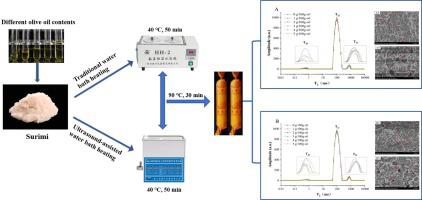Ultrasonics Sonochemistry ( IF 8.7 ) Pub Date : 2022-06-16 , DOI: 10.1016/j.ultsonch.2022.106065 Yufeng Lu 1 , Yajun Zhu 1 , Tao Ye 1 , Yongtao Nie 1 , Shaotong Jiang 1 , Lin Lin 1 , Jianfeng Lu 1

|
This study was conducted to evaluate the effects of extra virgin olive (EVO) oil incorporation on the physicochemical properties and microstructure of surimi gels subjected to ultrasound-assisted water-bath heating. As the oil content was increased from 0 to 5 g/100 g, the breaking force and gel strength of the surimi gels significantly decreased, while the whiteness level exhibited the opposite tendency irrespective of the heating method. Compared with the traditional water-bath heating method, the ultrasonic heating promoted the unfolding of the α-helix structure and intensified the formation of β-sheet content and non-covalent bonds (ionic bonds, hydrogen bonds, and disulfide bonds), especially disulfide bonds, which contributed to the further crosslinking of the proteins and to gelation, thereby improving the gels’ strength. In addition, smaller cavities and compact microstructures were observed in the low-oil (≤3 g/100 g) surimi gels under ultrasonic treatment, which effectively prevented water migration in the gel network and resulted in a high water holding capacity and uniform water distribution. However, the ultrasonic treatment barely remedied the poor microstructures of the high-oil (>3 g/100 g) surimi gels owing to oil coalescence, which weakened the protein–protein interaction. In conclusion, ultrasonic treatment combined with water-bath heating significantly improved the gelation properties of the low-oil surimi gels, although it did not remarkably improve those of the high-oil gels. The choice of a suitable oil concentration could be of great importance for the production and functioning of surimi products via ultrasound-assisted treatments.
中文翻译:

复合鱼糜凝胶的理化性质和微观结构:超声波处理和橄榄油浓度的影响
本研究旨在评估特级初榨橄榄油 (EVO) 油掺入对超声辅助水浴加热鱼糜凝胶的物理化学性质和微观结构的影响。随着含油量从 0 增加到 5 g/100 g,鱼糜凝胶的断裂力和凝胶强度显着下降,而白度水平则表现出相反的趋势,与加热方法无关。与传统的水浴加热方式相比,超声波加热促进了α-螺旋结构的展开,加强了β-折叠内容物和非共价键(离子键、氢键和二硫键)尤其是二硫键的形成。键,这有助于蛋白质的进一步交联和凝胶化,从而提高凝胶的强度。此外,超声处理的低油(≤3 g/100 g)鱼糜凝胶中出现了较小的空腔和致密的微观结构,有效地阻止了凝胶网络中的水迁移,从而具有较高的持水能力和均匀的水分布。然而,由于油聚结,超声处理几乎无法弥补高油(> 3 g / 100 g)鱼糜凝胶的不良微观结构,这削弱了蛋白质 - 蛋白质的相互作用。总之,超声波处理结合水浴加热显着改善了低油鱼糜凝胶的凝胶化性能,但并没有显着改善高油凝胶的凝胶化性能。选择合适的油浓度对于通过超声波辅助处理的鱼糜产品的生产和功能非常重要。











































 京公网安备 11010802027423号
京公网安备 11010802027423号